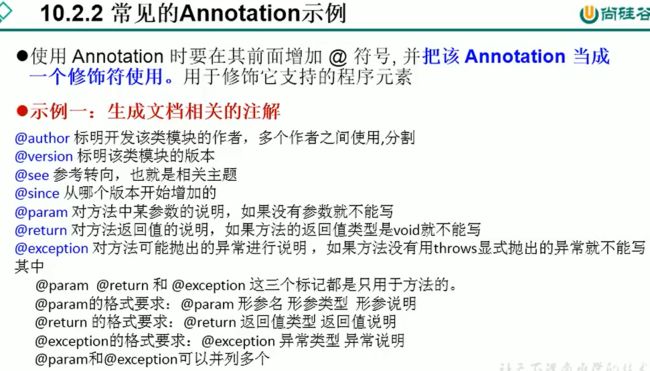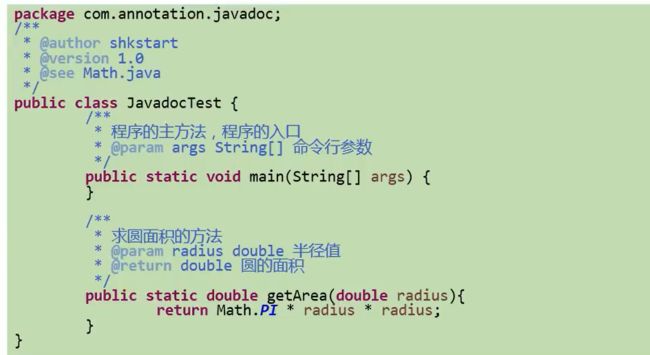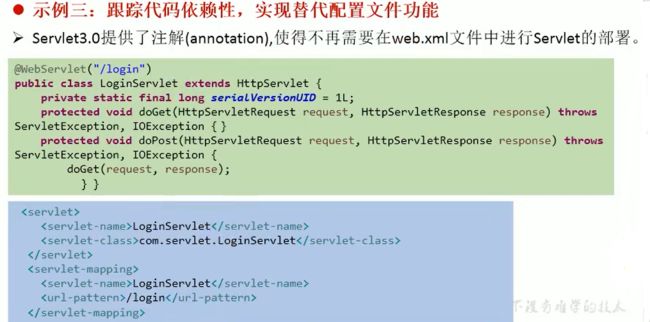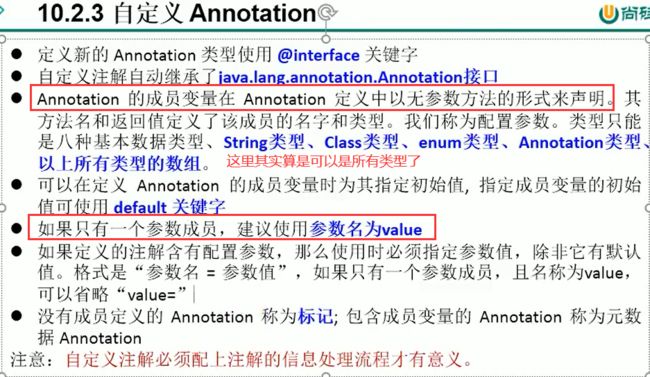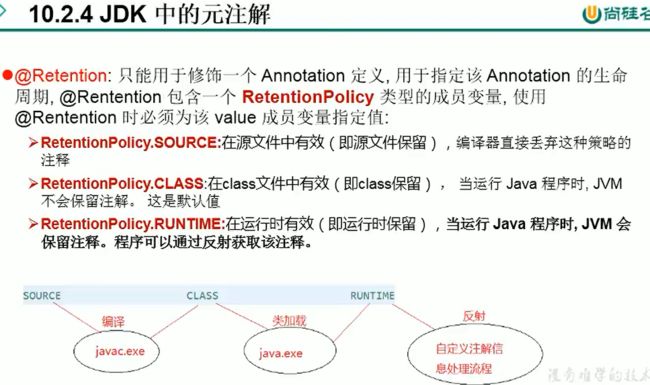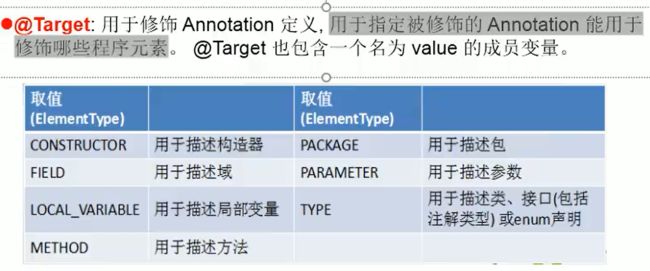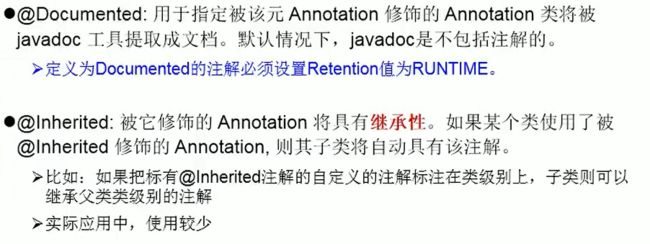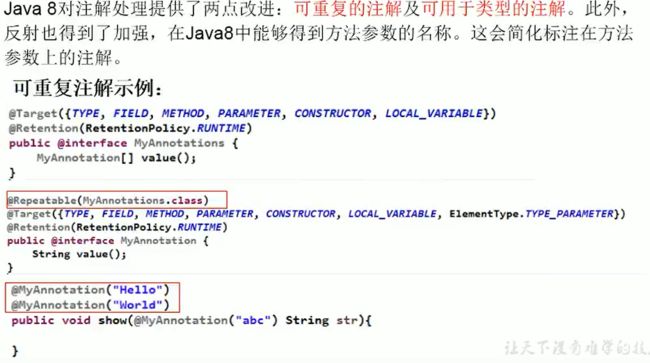JAVA注解Annotation
注解Annotation的使用举例
JDK内置的三个基本注解
package com.atguigu.java1;
import org.junit.Test;
import java.lang.annotation.Annotation;
import java.util.ArrayList;
import java.util.Date;
/**
* 注解的使用
*
* 1. 理解Annotation:
* ① jdk 5.0 新增的功能
*
* ② Annotation 其实就是代码里的特殊标记, 这些标记可以在编译, 类加载, 运行时被读取, 并执行相应的处理。通过使用 Annotation,
* 程序员可以在不改变原有逻辑的情况下, 在源文件中嵌入一些补充信息。
*
* ③在JavaSE中,注解的使用目的比较简单,例如标记过时的功能,忽略警告等。在JavaEE/Android
* 中注解占据了更重要的角色,例如用来配置应用程序的任何切面,代替JavaEE旧版中所遗留的繁冗
* 代码和XML配置等。
*
* 2. Annocation的使用示例
* 示例一:生成文档相关的注解
* 示例二:在编译时进行格式检查(JDK内置的三个基本注解)
@Override: 限定重写父类方法, 该注解只能用于方法
@Deprecated: 用于表示所修饰的元素(类, 方法等)已过时。通常是因为所修饰的结构危险或存在更好的选择
@SuppressWarnings: 抑制编译器警告
*/
public class AnnotationTest1 {
public static void main(String[] args) {
com.atguigu.java1.Person p = new com.atguigu.java1.Student();
p.walk();//学生走路
//使用过时的结构会有一个线,但是不影响使用,还可以用。
Date date = new Date(2020, 10, 11);
System.out.println(date);//Thu Nov 11 00:00:00 CST 3920
@SuppressWarnings("unused")//表示 定义的num没有使用
int num = 10;
// System.out.println(num);
@SuppressWarnings({ "unused", "rawtypes" })// rawtypes是说传参时也要传递带泛型的参数, ArrayList注解和代码
如何自定义注解
jdk中四个元注解的使用
jdk8.0新特性 可重复注解
jdk8.0新特性 类型注解
6.2 类型注解:
- ElementType.TYPE_PARAMETER 表示该注解能写在类型变量的声明语句中(如:泛型声明)。
- ElementType.TYPE_USE 表示该注解能写在使用类型的任何语句中。

加上红框这个词

不再报错

测试代码
自定义注解:MyAnnotation
package com.atguigu.java1;
import java.lang.annotation.*;
import static java.lang.annotation.ElementType.*;
/**
*自定义注解
*
* 6. jdk 8 中注解的新特性:可重复注解、类型注解
*
* 6.1 可重复注解:① 在MyAnnotation上声明@Repeatable,成员值为MyAnnotations.class
* ② MyAnnotation的Target和Retention等元注解与MyAnnotations相同。
*
* 6.2 类型注解:
* ElementType.TYPE_PARAMETER 表示该注解能写在类型变量的声明语句中(如:泛型声明)。
* ElementType.TYPE_USE 表示该注解能写在使用类型的任何语句中。
*/
@Inherited//加上这个注解后 标明被它修饰的 Annotation 将具有继承性。
@Repeatable(MyAnnotations.class)//这样后就能两排可重复注解不报错了
//@MyAnnotation(value="hi")
//@MyAnnotation(value="abc")这样不报错了
@Retention(RetentionPolicy.RUNTIME)
@Target({TYPE, FIELD, METHOD, PARAMETER, CONSTRUCTOR, LOCAL_VARIABLE,TYPE_PARAMETER,TYPE_USE})
//Target表示这个注解可以修饰什么元素,有TYPE该注解就能修饰类、接口,有FIELD就能修饰字段声明,有METHOD就能修饰方法
public @interface MyAnnotation {
String value() default "hello";
}
自定义注解(为重复注解而写的自定义注解):MyAnnotations
package com.atguigu.java1;
import java.lang.annotation.Inherited;
import java.lang.annotation.Retention;
import java.lang.annotation.RetentionPolicy;
import java.lang.annotation.Target;
import static java.lang.annotation.ElementType.*;
/**
*重复注解
*/
@Inherited
@Retention(RetentionPolicy.RUNTIME)//和MyAnnotation一样的生命周期
@Target({TYPE, FIELD, METHOD, PARAMETER, CONSTRUCTOR, LOCAL_VARIABLE})//和MyAnnotation一样的能修饰的范围
public @interface MyAnnotations {
MyAnnotation[] value();
}
注解测试总类:AnnotationTest
package com.atguigu.java1;
import org.junit.Test;
import java.lang.annotation.Annotation;
import java.util.ArrayList;
import java.util.Date;
/**
* 注解的使用
*
* 1. 理解Annotation:
* ① jdk 5.0 新增的功能
*
* ② Annotation 其实就是代码里的特殊标记, 这些标记可以在编译, 类加载, 运行时被读取, 并执行相应的处理。通过使用 Annotation,
* 程序员可以在不改变原有逻辑的情况下, 在源文件中嵌入一些补充信息。
*
* ③在JavaSE中,注解的使用目的比较简单,例如标记过时的功能,忽略警告等。在JavaEE/Android
* 中注解占据了更重要的角色,例如用来配置应用程序的任何切面,代替JavaEE旧版中所遗留的繁冗
* 代码和XML配置等。
*
* 2. Annocation的使用示例
* 示例一:生成文档相关的注解
* 示例二:在编译时进行格式检查(JDK内置的三个基本注解)
@Override: 限定重写父类方法, 该注解只能用于方法
@Deprecated: 用于表示所修饰的元素(类, 方法等)已过时。通常是因为所修饰的结构危险或存在更好的选择
@SuppressWarnings: 抑制编译器警告
* 示例三:跟踪代码依赖性,实现替代配置文件功能
*
*
* 3. 如何自定义注解:参照@SuppressWarnings定义
* ① 注解声明为:@interface
* ② 内部定义成员,通常使用value表示
* ③ 可以指定成员的默认值,使用default定义
* ④ 如果自定义注解没有成员,表明是一个标识作用。
如果注解有成员,在使用注解时,需要指明成员的值。//例如@MyAnnotation("hi")中赋值 hi
自定义注解必须配上注解的信息处理流程(使用反射)才有意义。
自定义注解通过都会指明两个元注解:Retention、Target
4. jdk 提供的4种元注解
元注解:对现有的注解进行解释说明的注解
Retention:指定所修饰的 Annotation即注解的生命周期:三种指定:SOURCE\CLASS(默认的指定)\RUNTIME
只有声明为RUNTIME生命周期的注解,才能通过反射获取。
Target:用于指定被修饰的 Annotation 能用于修饰哪些程序元素
*******出现的频率较低*******
Documented:表示所修饰的注解在被javadoc解析时,保留下来。
Inherited:被它修饰的 Annotation 将具有继承性。
5.通过反射获取注解信息 ---到反射内容时系统讲解
6. jdk 8 中注解的新特性:可重复注解、类型注解
6.1 可重复注解:① 在MyAnnotation上声明@Repeatable,成员值为MyAnnotations.class
② MyAnnotation的Target和Retention等元注解与MyAnnotations相同。
6.2 类型注解:
ElementType.TYPE_PARAMETER 表示该注解能写在类型变量的声明语句中(如:泛型声明)。
ElementType.TYPE_USE 表示该注解能写在使用类型的任何语句中。
*/
public class AnnotationTest {
public static void main(String[] args) {
Person p = new Student();
p.walk();
//使用过时的结构会有一个线,但是不影响使用,还可以用。
Date date = new Date(2020, 10, 11);
System.out.println(date);
@SuppressWarnings("unused")//表示 定义的num没有使用
int num = 10;
// System.out.println(num);
@SuppressWarnings({ "unused", "rawtypes" })// rawtypes是说传参时也要传递带泛型的参数, ArrayList
